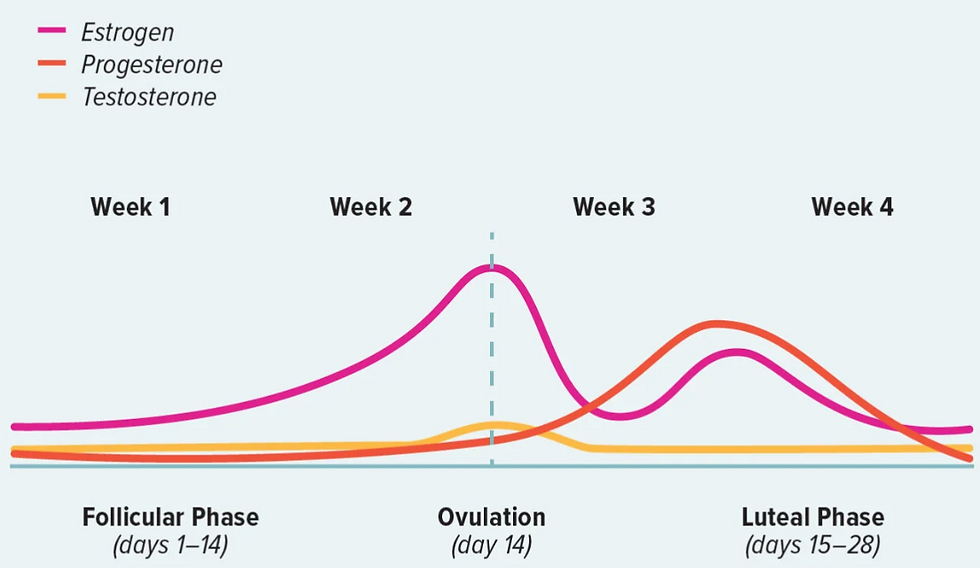Maximizing Fitness: Understanding the Impact of Your Monthly Hormone Cycle on Exercise Performance
- Yvonne Heiden

- Mar 17
- 4 min read
The menstrual cycle isn’t just about periods—it’s also something that can significantly influence how you feel and perform in the gym or during sports. Understanding the science behind the cycle and how hormones fluctuate throughout the month can help you tailor your workouts for optimal performance, energy, and recovery. Let’s break it down and look at how each phase of the cycle can affect your fitness journey and what you can do to make the most of it.
1. The Menstrual Cycle: A Quick Overview
The average menstrual cycle lasts about 28 days, but it can vary from person to person. It’s divided into four main phases, each characterized by different hormonal changes. These hormones—mainly oestrogen and progesterone—play a key role in regulating everything from energy levels to muscle recovery. Here’s a quick look at the phases:

Menstrual Phase (Days 1-5): This is the start of your cycle when you get your period.
Follicular Phase (Days 6-14): After your period, oestrogen begins to rise and the body starts preparing for ovulation.
Ovulation Phase (Around Day 14): Oestrogen peaks, and your body releases an egg from the ovary.
Luteal Phase (Days 15-28): After ovulation, progesterone increases to support potential pregnancy, and energy levels may fluctuate.
2. How Hormones Impact Your Gym & Sports Performance
Let’s dive into how each phase of the cycle might influence how you feel in the gym and during sports.

Menstrual Phase (Days 1-5):
While this phase is often associated with fatigue and discomfort, it doesn’t mean you need to skip the gym. Some women feel great and can still perform well, but if you’re feeling low energy or experiencing cramps, listen to your body and adjust. This might be a good time for lighter activities like yoga, stretching, or low-intensity cardio.
Follicular Phase (Days 6-14):
This is typically the phase when energy levels are higher, and you might feel stronger and more motivated. As oestrogen rises, muscle repair and growth are supported, so strength training can feel easier and more rewarding. This is an ideal time for more intense workouts like heavy lifting, HIIT, or strength training. You may also notice improved endurance in cardio workouts, so it’s a great time to push yourself.
Ovulation Phase (Around Day 14):
Oestrogen peaks around ovulation, and this is when many women feel at their strongest. Your body’s pain tolerance is higher, so you may feel more confident and energized. It's a good time for high-intensity workouts or sports that require power and explosiveness (like sprinting or competitive sports). However, since your body is more prone to injury during this phase (due to joint looseness), be cautious with your form and intensity.
Luteal Phase (Days 15-28):
As progesterone rises, energy can start to dip, and you might feel more fatigued or less motivated. You may also experience bloating, mood swings, and an increase in appetite. This phase is more about recovery and tuning into your body’s needs. It’s a good time to shift to lower-intensity workouts or focus on recovery-based activities like stretching, Pilates, or swimming. However, if you’re feeling good, light-to-moderate weightlifting is still beneficial.
3. Tips for Optimizing Performance Throughout the Cycle
Now that you know how the menstrual cycle affects performance, here are some practical tips to help you adjust your workouts according to each phase:
Track Your Cycle:
Start by tracking your menstrual cycle and your symptoms. Apps like Clue or Flo can help you get a better idea of when you’re in each phase. This allows you to plan your workouts in advance and make any necessary adjustments.
Listen to Your Body:
Every woman’s cycle is different. Some may feel fantastic during their period, while others might struggle with fatigue or cramps. The key is to listen to your body and adjust your workouts accordingly.
Adjust Intensity Based on Energy Levels:
If you're experiencing high energy and motivation, take advantage of that by going harder with your workouts. During lower-energy phases, focus on recovery and lower-intensity activities. You can always make up for lost intensity in the following phases.

Nutritional Support:
Your hormones influence your appetite and nutritional needs. During the luteal phase, cravings for carbs and snacks may increase. Make sure to fuel your body with whole foods and balanced meals to support your energy levels and recovery. Stay hydrated, and consider adjusting your macros (carbs, protein, fats) based on the phase you're in. If you find it impossible to resist sweet treats before/during your period, then plan them into your calorie intake rather than trying to abstain and munching them in addition to your usual meals.

Rest and Recovery:
Never underestimate the importance of rest, especially during the menstrual and luteal phases when your body may need extra time to recover. Prioritize sleep, stretching, and even rest days as needed to keep your body in top condition.
4. Conclusion
Your hormone cycle doesn’t have to be a hindrance to your gym and sports performance. By understanding how your body’s hormones fluctuate throughout the month, you can adapt your workouts and optimize your energy, strength, and recovery. With a little awareness and planning, you can make the most of each phase, ensuring that your fitness routine supports your body’s natural rhythm.
Remember, your body is constantly changing, and that’s something to celebrate. So embrace the cycle, adjust as needed, and keep crushing those workouts!






Comments